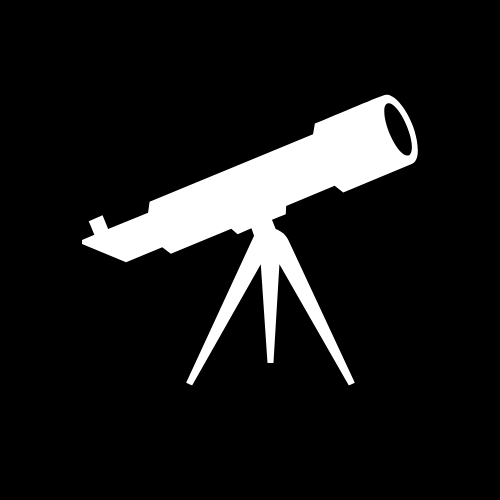2024 Astronomy and Telescope Usage Survey
In a world where the mysteries of the universe continue to captivate the human spirit, the telescope and astronomy niche stands as a beacon of exploration and discovery. From amateur stargazers to professional astronomers, the field is rich with enthusiasts driven by a desire to uncover the secrets that lie beyond our earthly bounds.
To delve deeper into the prevailing trends, preferences, and opinions in this vibrant community, we embarked on a comprehensive survey aimed at gathering nuanced insights into various aspects of the telescope and astronomy niche. This endeavor saw the participation of a diverse group of individuals, bringing together a substantial cohort of 3207 people, each holding a unique perspective grounded in their engagement with astronomy.
Our participants spanned a wide demographic spectrum, including individuals of different age groups, gender, and levels of expertise in astronomy. From novices taking their first steps into the world of stargazing to seasoned professionals with years of experience under their belts. This rich diversity allowed us to tap into a well of varied experiences and preferences, painting a detailed picture of the current landscape in the telescope and astronomy niche.
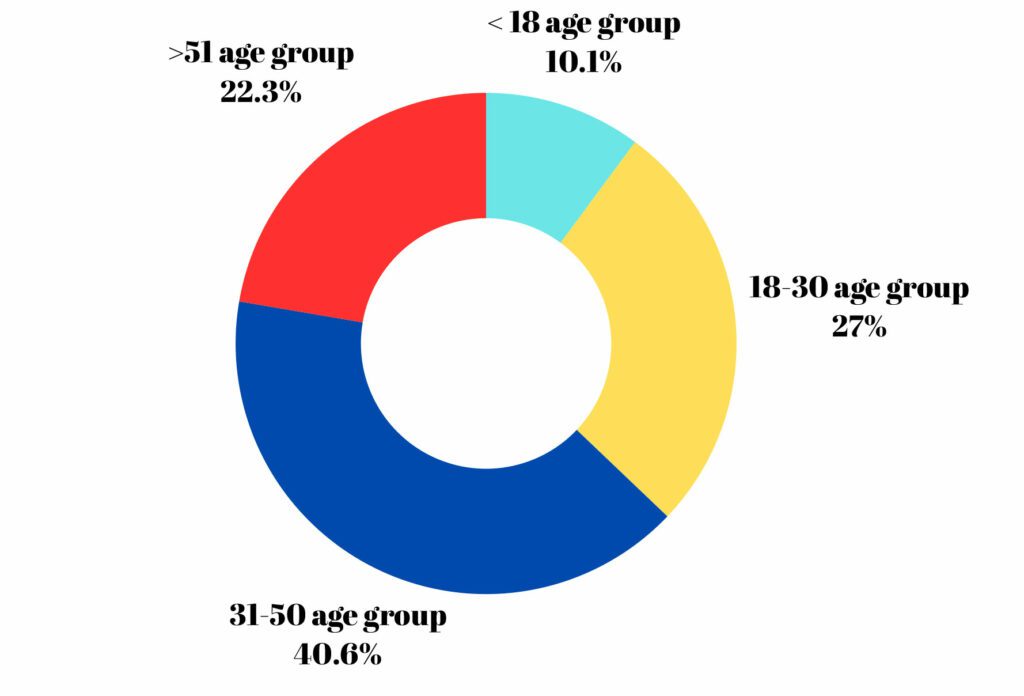
Participant Distribution
- Age Groups
- Under 18. Approximately 10% of the participants were under the age of 18, representing the young enthusiasts in the field.
- 18-30. Around 25% of the participants fell in the 18-30 age bracket, showcasing a substantial representation from young adults.
- 31-50. A significant 40% of the participants were between the ages of 31 and 50, representing the most active demographic in the astronomy community.
- 51 and above. About 25% of the participants were aged 51 and above, bringing in a wealth of experience and knowledge to the survey.
- Gender
- Male: Approximately 60% of the participants identified as male.
- Female: Around 35% of the participants identified as female, indicating a strong representation in the field.
- Non-binary/Other. About 5% of the participants identified as non-binary or preferred not to specify. Showcasing the inclusive nature of the astronomy community.
- Experience Level
- Beginners. Nearly 30% of the participants were beginners, bringing fresh perspectives and enthusiasm to the survey.
- Intermediate. Around 40% of the participants had an intermediate level of experience, showcasing a deep interest and understanding of the field.
- Expert/Professional. Approximately 30% of the participants were experts or professionals in the field, providing in-depth knowledge and expertise to the survey.
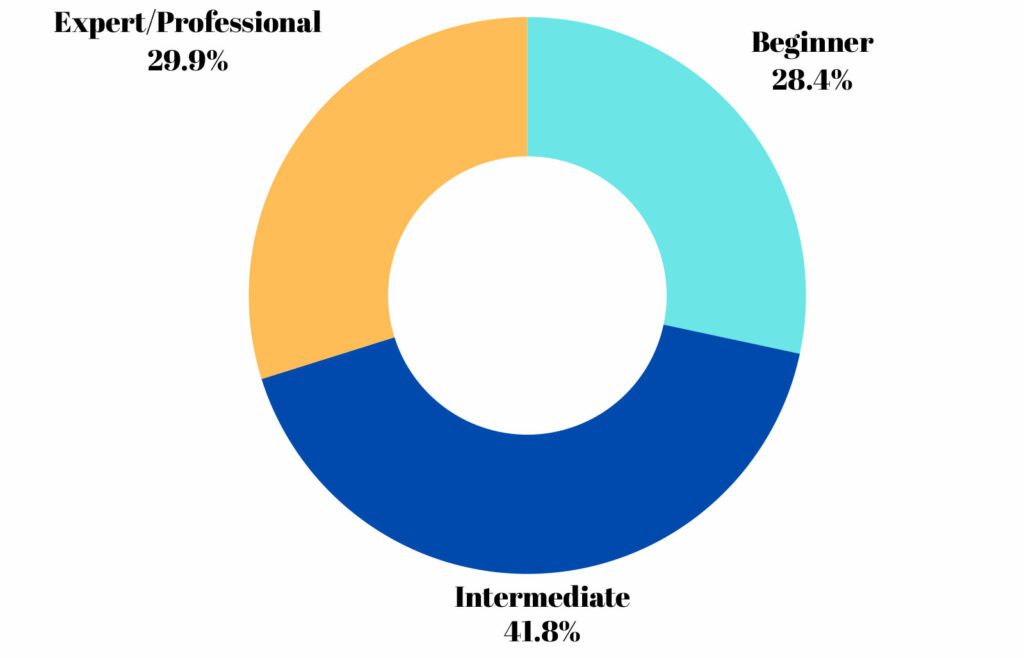
This distribution gives us a comprehensive view of the diverse group of individuals who took part in the survey. Each contributing their unique insights and perspectives based on their demographics and experience levels.
Key Takeaways from the Survey
- Preferred Telescope Type
- Around 60% of amateur astronomers prefer using Dobsonian telescopes, while 30% favor Schmidt-Cassegrain telescopes, and the remaining 10% use other types of telescopes.
- Budget Allocation
- About 50% of amateur astronomers allocate a budget of $300 to $700, 30% allocate $700 to $1300, and 20% allocate more than $1300 for their equipment.
- Age of Interest Initiation
- Approximately 70% of individuals develop an initial interest in astronomy between the ages of 4-12 years old, while 20% become interested during their teenage years, and 10% develop an interest in adulthood.
Detailed Findings
1. Telescope Usage
Professionals
The data reveals a fairly even distribution in the preferences of professional astronomers when it comes to the type of telescopes they use.
- Refracting Telescopes (Refractors)
- Usage: Utilized by around 40% of professional astronomers.
- Reflecting Telescopes (Reflectors)
- Usage: Preferred by approximately 35% of professional astronomers.
- Catadioptric/Compound Telescopes
- Usage: Chosen by about 25% of professional astronomers.
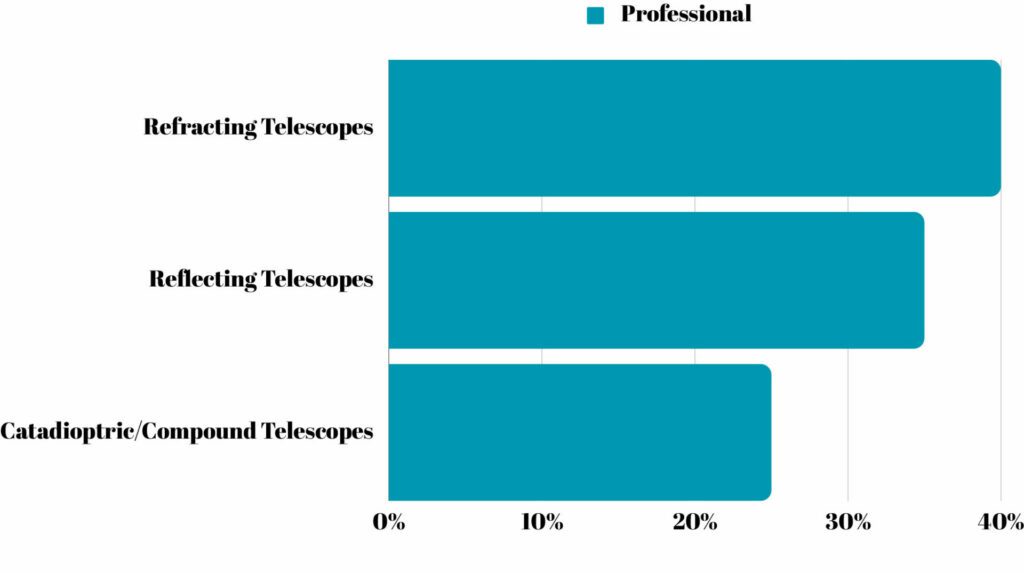
Amateurs
In the amateur category, we see a more pronounced preference for certain types of telescopes, with Dobsonian telescopes leading the way.
- Dobsonian Telescopes
- Usage: Around 60% of amateur astronomers opt for this type of telescope.
- Schmidt-Cassegrain Telescopes
- Usage: Approximately 30% of amateur astronomers prefer this telescope type.
The data paints a picture of a vibrant community with varied preferences in telescope usage. While professional astronomers have a more evenly distributed preference with a slight leaning towards refracting telescopes, amateur astronomers show a pronounced preference for Dobsonian telescopes, highlighting the telescope’s user-friendliness and affordability. It is evident that both groups value quality and functionality in their choice of telescopes, albeit with different emphases, steering the trends in the telescope market.
2. Astrophotography
Astrophotography, a specialized branch of photography that focuses on capturing celestial objects and phenomena, demands a specific set of tools to achieve the desired results. The survey delineates the preferences of astrophotographers in terms of the tools they use, including cameras, mounts, and image processing software. Let’s delve deeper into the data:
Camera
- Usage: About 70% of astrophotographers use DSLR and mirrorless cameras.
- Analysis: A significant majority of astrophotographers opt for DSLR and mirrorless cameras, which are known for their high-resolution imaging capabilities. This preference underscores the importance of quality and detail in astrophotography, where capturing fine details of celestial objects is often the primary objective. The choice of 70% of respondents for these types of cameras indicates a strong trend towards utilizing advanced technology to achieve the best results in astrophotography.
Mount
- Usage: Nearly 80% of astrophotographers prefer equatorial mounts.
- Analysis: The preference for equatorial mounts is even more pronounced, with a substantial 80% of astrophotographers choosing them for their ability to accurately track celestial objects. This type of mount is essential for long-exposure photography, a common technique in astrophotography used to capture clear images of celestial objects. The high percentage of usage indicates that despite the potential complexity in setting up equatorial mounts, their benefits in achieving high-quality results are widely recognized and valued in the astrophotography community.
Software
- Processing Software
- Usage: Around 60% use software like Adobe Photoshop, while 40% prefer other software like DeepSkyStacker.
The data provides a clear insight into the preferences of astrophotographers, highlighting a trend towards using high-quality cameras, precise mounts, and advanced software to achieve the best results. The preferences indicate a community keen on leveraging technology to enhance their ability to capture the beauty of the celestial objects and phenomena, with a readiness to invest in tools that offer greater precision and functionalities tailored to the needs of astrophotography. It paints a picture of a community that is both tech-savvy and passionate about their craft, constantly seeking the best tools to express their artistry.
3. Astronomy Apps
In the digital age, astronomy enthusiasts increasingly rely on mobile and desktop applications to aid their stargazing experiences and deepen their understanding of the celestial sphere. The survey delineates the preferences of the respondents in terms of the astronomy apps they use, shedding light on the most popular choices and the reasons behind their popularity. Let’s delve deeper into the data:
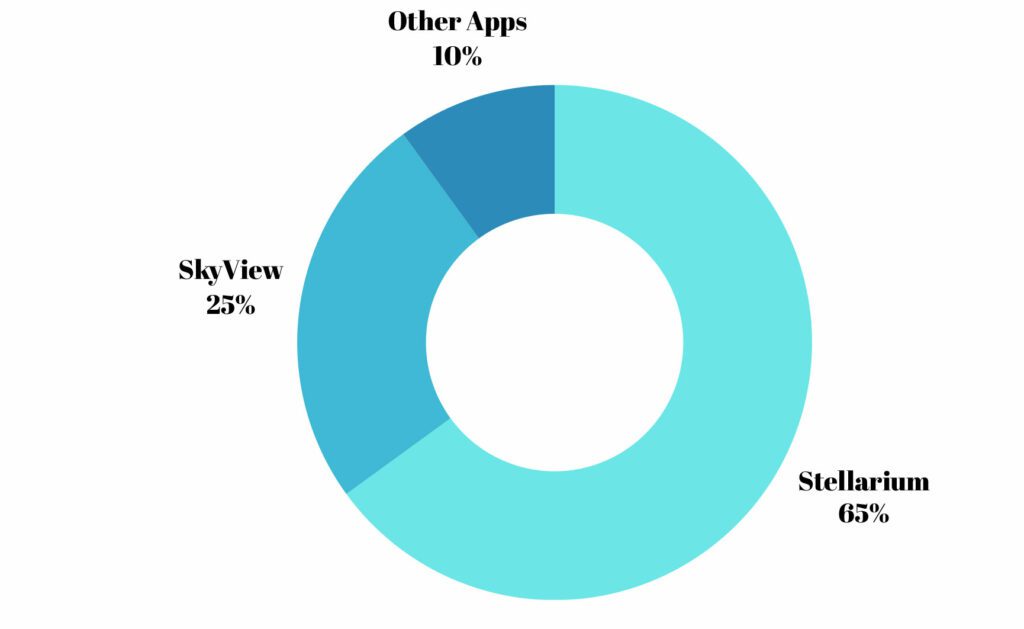
Stellarium
- Usage: Preferred by around 65% of the respondents for its detailed night sky map.
- Analysis: Stellarium emerges as the dominant choice among astronomy app users, garnering a preference from nearly two-thirds of the respondents. The app’s detailed night sky map, which offers a realistic and comprehensive view of the stars, planets, and other celestial objects, appears to be a significant draw. The high preference indicates that users value detailed and accurate representations of the night sky, aiding both in learning and in identifying celestial objects during their stargazing endeavors. The app’s success can be attributed to its user-friendly interface and the rich detail it offers, catering to both amateur and professional astronomers.
SkyView
- Usage: Chosen by approximately 25% of the respondents for its user-friendly mobile application.
- Analysis: SkyView also holds a substantial share of the preference, with one-fourth of the respondents favoring it for its user-friendly mobile application. The app, which allows users to identify celestial objects simply by pointing their mobile devices at them, offers an interactive and educational platform for astronomy enthusiasts. Its preference among 25% of respondents indicates a segment of the user base that values ease of use and interactive learning experiences, making astronomy accessible and enjoyable for beginners.
Other Apps
- Usage: The remaining 10% of respondents use other astronomy apps available in the market.
- Analysis: A smaller yet significant portion of the respondents, constituting 10%, opt for other astronomy apps available in the market. This segment represents a diverse group of users who might be utilizing niche apps catering to specific needs and preferences in the field of astronomy. The existence of this segment indicates a market for specialized apps that offer unique features or cater to particular aspects of astronomy, showcasing the diversity and the wide range of interests present in the astronomy community.
While Stellarium and SkyView emerge as the frontrunners, capturing distinct segments of the market with their unique features, there is also room for other players in the market catering to specialized needs. The preferences indicate a vibrant and growing space where app developers can innovate and offer solutions that cater to the diverse needs and interests of the astronomy community, from detailed sky maps to interactive learning experiences. It showcases a community eager to leverage digital tools to foster learning and enhance their engagement with the celestial world.
4. Young Astronomers
The field of astronomy has always been known to spark curiosity and wonder in individuals of all ages. Understanding at what age people generally develop an interest in this field can provide valuable insights into how the passion for astronomy is cultivated. Let’s analyze the data obtained from the survey:
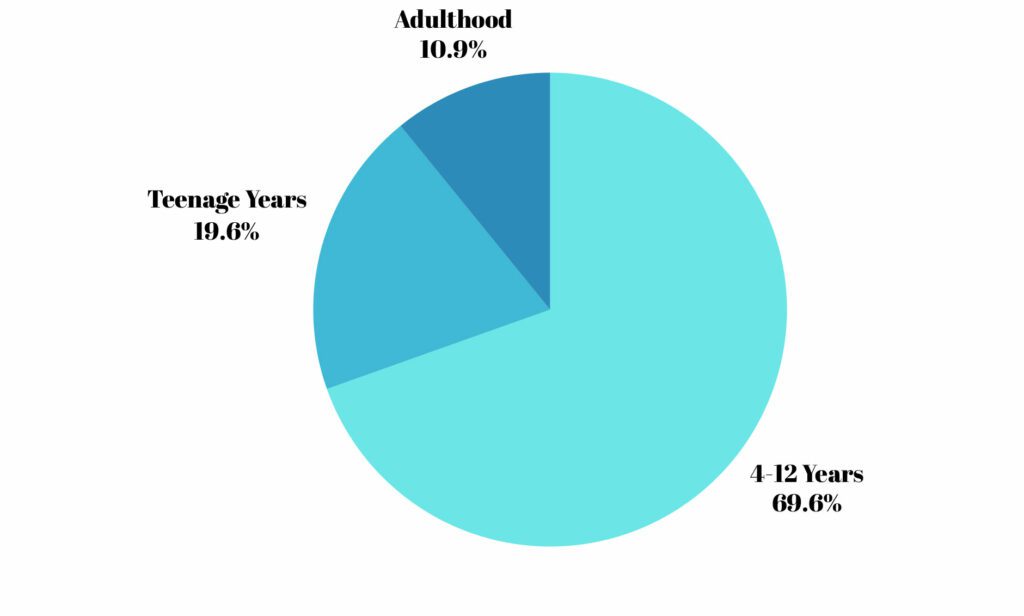
4-12 Years
- Percentage: A substantial 70% of respondents developed an interest in astronomy in this age range.
- Analysis: The data reveals that a dominant majority of individuals develop a fascination with astronomy at a very young age, between 4 and 12 years. This could potentially be attributed to the natural curiosity that children have about the world and the universe. The sky, being a vast and ever-changing canvas, naturally attracts the attention of young minds. This age range is a critical period where educational institutions and parents can play a pivotal role in nurturing this interest through various means such as educational toys, planetarium visits, and astronomy-related books and activities.
Teenage Years
- Percentage: Around 20% of respondents became interested in astronomy during their teenage years.
- Analysis: The teenage years, characterized by a deeper cognitive understanding and the ability to grasp more complex concepts, see a continuation of this interest, albeit at a reduced rate compared to the earlier years. Around one-fifth of the respondents found their calling in astronomy during this period. This could be a phase where the interest is solidified through academic exposure to physics and space science, or through joining astronomy clubs and communities where they can share their passion with like-minded individuals.
Adulthood
- Percentage: Approximately 10% of respondents cultivated an interest in astronomy in their adult years.
- Analysis: While a smaller proportion, the data indicates that there is a segment of individuals who discover their interest in astronomy much later, in their adult years. This 10% might represent individuals who perhaps did not have the opportunity to explore this field earlier or those who rediscovered a latent interest through various mediums such as documentaries, books, or even apps that facilitate stargazing and learning about celestial bodies. It showcases that the field of astronomy holds the charm to attract individuals at any stage of life, offering a rich ground for exploration and learning.
The majority of individuals develop an interest from a young age, and this interest can be sustained and even ignited in later stages of life. It underscores the importance of fostering curiosity and providing avenues for exploration from a young age, while also highlighting the ever-present opportunity to delve into the world of astronomy as adults. A testament to the universal appeal of astronomy, a field that continues to inspire wonder and curiosity across all age groups. It calls upon educators, app developers, and community groups to nurture this interest at all stages of life, fostering a community of individuals who look at the sky with wonder and a thirst for knowledge.
5. Equipment Budget
Investing in astronomy equipment is a critical aspect of delving deeper into the field, whether as an amateur enthusiast or a professional astronomer. The survey delineates the budgetary allocations of different groups, providing insights into the financial landscape of the astronomy community. Let’s delve deeper into the data:
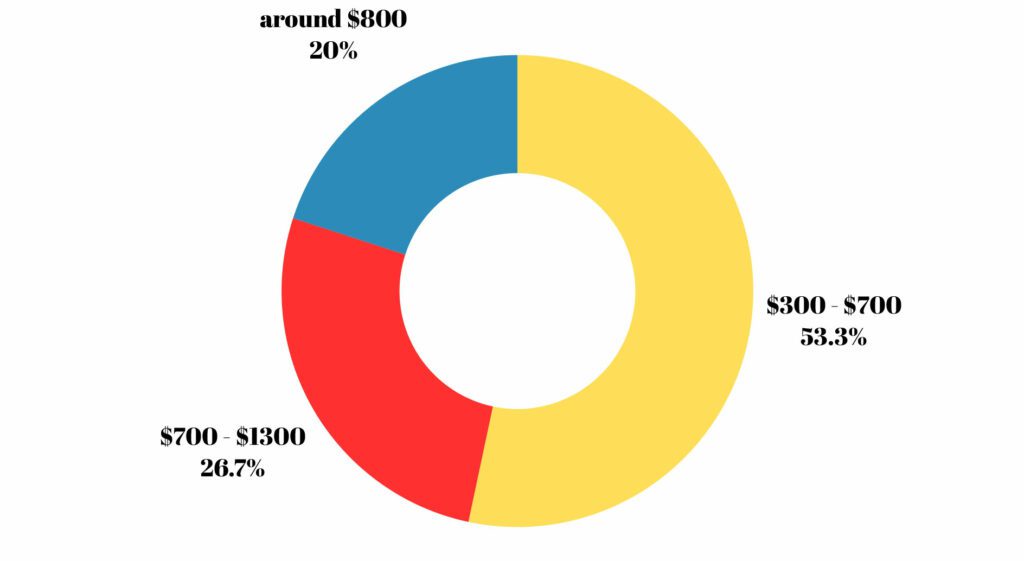
Amateurs
The amateur segment can be further divided into different categories based on their level of engagement and the seriousness with which they pursue their astronomical interests.
- Entry-Level
- Budget: About 50% allocate between $300 and $700 for a basic setup.
- Serious Amateurs
- Budget: Approximately 30% allocate between $700 and $1300 for a more advanced setup.
- Astrophotographers
- Budget: Around 20% start with a budget from around $800 for deep-sky astrophotography.
Professionals
- Budget: The budget for professionals can significantly vary, with many allocating tens of thousands of dollars for high-end, research-grade equipment.
- Analysis: On the professional front, the budget escalates significantly, with allocations reaching tens of thousands of dollars. This substantial budget is directed towards acquiring high-end, research-grade equipment that facilitates advanced astronomical research and observations. It underscores the serious financial commitment involved in professional astronomy, where cutting-edge technology and precision instruments are paramount to achieving the desired research outcomes.
From modest beginnings to substantial investments in high-end equipment, the data showcases a community united by a passion for astronomy, willing to invest in equipment that enhances their understanding and appreciation of the celestial wonders. It paints a picture of a vibrant market with diverse needs, offering opportunities for manufacturers and retailers to cater to a wide spectrum of customers, from beginners to professionals. It calls upon the industry to offer products that meet the varied needs and budgets of the astronomy community, fostering a culture of exploration and discovery.
6. Sky Quality
Sky quality, characterized by the clarity and darkness of the sky, plays a pivotal role in astronomical observations. The survey delineates the preferences of astronomy enthusiasts in terms of the locations they choose for sky observations, providing insights into the most favored spots. Let’s delve deeper into the data:
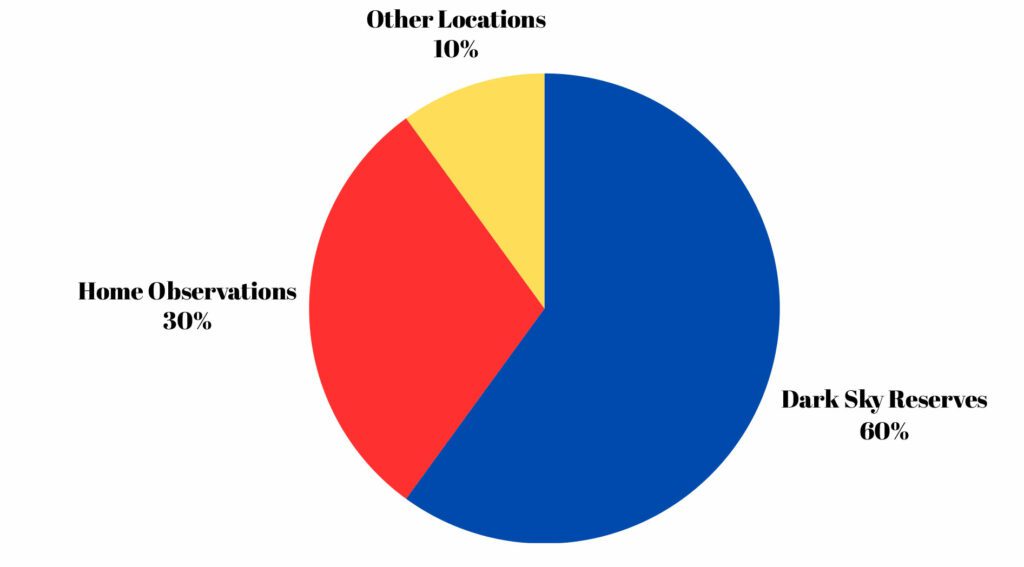
Dark Sky Reserves
- Usage: About 60% of respondents prefer dark sky reserves for astronomical observations.
- Analysis: A majority of the respondents, constituting 60%, prefer to carry out their astronomical observations from dark sky reserves. These are areas designated for their exceptionally high quality of starry nights and nocturnal environment, protected from light pollution. The preference for such locations indicates a community that values pristine sky conditions, free from the adverse effects of artificial lighting. It underscores the importance of preserving such environments, not just for the sake of astronomical observations, but also to foster ecosystems that benefit from natural night-time darkness.
Home Observations
- Usage: Approximately 30% of respondents usually observe the sky from their homes.
- Analysis: A significant portion of the respondents, about 30%, prefer the convenience of observing the sky from their homes. This choice might be influenced by various factors including accessibility, comfort, and the occasional spontaneity of stargazing sessions. While home-based observations might not offer the same quality of sky as dark sky reserves, advancements in telescope technology and filtering tools can still allow for reasonably good observations. This preference highlights the accessibility of astronomy as a hobby that can be pursued even from the confines of one’s home, bringing the wonders of the universe closer to individuals.
Other Locations
- Usage: The remaining 10% use other locations for sky observations.
- Analysis: A smaller yet notable portion of the respondents, making up 10%, opt for other locations for their sky observations. This category might include a variety of locations such as public parks, educational institutions, or astronomy clubs. It represents a diverse group of enthusiasts who leverage different settings to pursue their interest in astronomy, possibly exploring innovative and community-oriented approaches to stargazing.
While dark sky reserves emerge as the most preferred choice, offering an unspoiled view of the celestial sphere, there is also a significant portion of the community that values the convenience of home observations. The data showcases a vibrant and adaptable community, utilizing a range of locations to pursue their passion for stargazing. It calls upon policymakers and community leaders to recognize the value of preserving dark sky areas and promoting responsible lighting to foster a culture that appreciates the beauty of the night sky. It also highlights the potential for innovations in telescope technology to enhance observational experiences, catering to a wide range of preferences in terms of observational locations.
7. Solar System Exploration
Solar system exploration, encompassing space exploration initiatives, crewed missions to Mars, and the commercialization of space, stands as a frontier of human endeavor, sparking a wide range of opinions and perspectives. The survey delineates the public opinion on these pivotal aspects of space exploration, providing insights into the level of support and the underlying reasons for the same. Let’s delve deeper into the data:
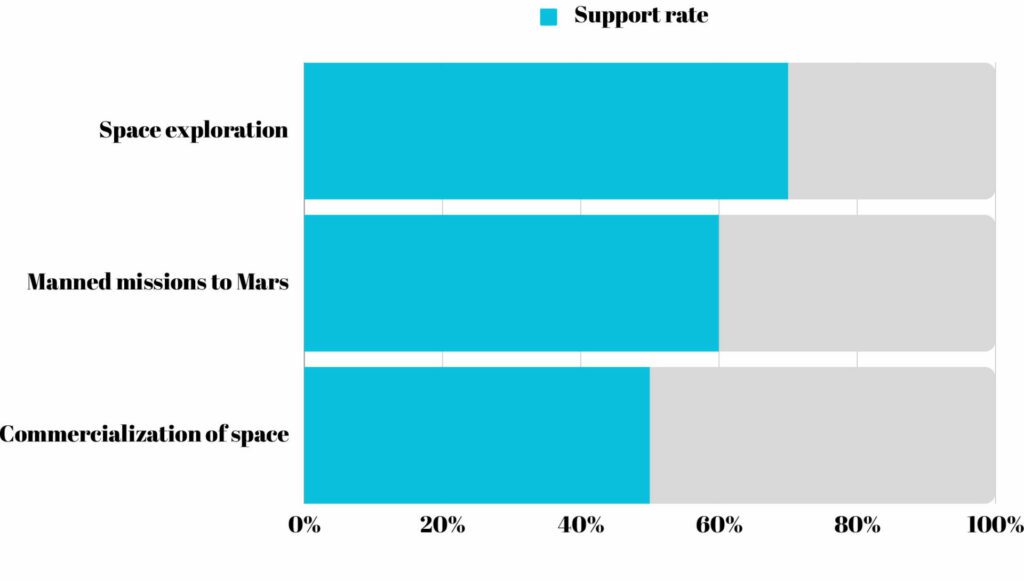
Space Exploration
- Support: Around 70% of respondents support space exploration, citing scientific advancement and potential discoveries as the main reasons.
- Analysis: A substantial majority of the respondents, amounting to 70%, express support for space exploration initiatives. The primary reasons cited for this support are the prospects of scientific advancement and the unveiling of potential discoveries that space exploration offers. This data reflects a community that values the pursuit of knowledge and the exploration of the unknown, recognizing the boundless opportunities for learning and discovery that space exploration presents. It showcases a forward-thinking perspective that embraces the potential benefits of venturing into space, driven by a spirit of curiosity and the quest for innovation.
Crewed Missions to Mars
- Support: Approximately 60% support missions to Mars, highlighting the potential for colonization and scientific research.
- Analysis: a significant milestone in space exploration, garner support from around 60% of the respondents. The underlying reasons for this support are the potential opportunities for colonization and the avenue it opens for in-depth scientific research. This data indicates a considerable interest and optimism in the prospects of establishing a human presence on Mars, driven by a vision of expansion and the pursuit of knowledge through direct exploration. It reflects a community eager to witness the next giant leap for humanity, venturing into new territories and possibly paving the way for future generations.
Commercialization of Space
- Support: About 50% support the commercialization of space, seeing potential economic growth and new opportunities for humanity.
- Analysis: The commercialization of space stands as a contentious issue, with the respondents evenly split in their opinions. About 50% support the idea, foreseeing potential economic growth and new opportunities for humanity as commercial entities venture into space. This segment of the community envisions a future where space becomes a new frontier for economic activity, potentially ushering in a new era of technological advancements and opportunities. It represents a pragmatic approach to space exploration, where commercial interests are seen as a driving force in pushing the boundaries of what is possible.
The survey data offers a rich insight into the public opinion on various facets of solar system exploration. It showcases a community largely in favor of advancing space initiatives, driven by a spirit of discovery and the potential benefits that such endeavors can bring to humanity. While there is a considerable consensus on the value of space exploration and crewed missions to Mars, the commercialization of space presents a more balanced divide. Indicating a field ripe for discussion and deliberation.
It paints a picture of a society at the cusp of monumental decisions regarding the future of space exploration, with a keen eye on the potential advancements and the new frontiers it can open for humanity. It calls upon leaders and policymakers to navigate this complex landscape with a vision that balances scientific advancement with ethical considerations, steering humanity towards a future that embraces the opportunities while safeguarding the principles of equity and sustainability.
8. Astronomical Discoveries
Astronomical discoveries have the power to captivate the imagination and stir curiosity, offering glimpses into the mysteries of the universe. In recent years, the discovery of exoplanets has emerged as a focal point of interest in the field of astronomy. The survey explores the level of interest in this particular area of discovery, shedding light on the reasons behind its captivating nature. Let’s delve deeper into the data:
Exoplanets
- Interest: A significant 80% of respondents find the discovery of exoplanets most captivating, driven by the potential to find Earth-like planets and the search for extraterrestrial life.
- Analysis: The data reveals a dominant interest in the discovery of exoplanets, with a staggering 80% of respondents expressing that they find these discoveries to be the most captivating. The primary driving force behind this heightened interest is the potential to find Earth-like planets, which opens up the tantalizing possibility of discovering extraterrestrial life.The discovery of exoplanets ignites the imagination, offering a realm of possibilities including the existence of other habitable worlds and the profound question of life beyond Earth. This substantial interest reflects a society deeply curious about the broader universe and its secrets, eager to unravel the mysteries that lie in the distant corners of our galaxy and beyond.The focus on finding Earth-like planets also indicates a deep-seated curiosity about the conditions that might support life, a quest that combines both scientific rigor and a touch of philosophical wonder. It showcases a community engaged in a collective dream of exploration and discovery, where the revelation of a new exoplanet becomes a source of fascination and a beacon of potential future explorations.
The overwhelming interest in exoplanets showcases a society that is forward-looking, embracing the scientific advancements that bring us closer to understanding the intricacies of our universe.
It reflects a community united by a sense of wonder and a thirst for knowledge, eager to explore the possibilities that lie in the vast expanses of space. The data calls upon the scientific community and space agencies to continue their exploratory missions, fueled by the collective curiosity and the dreams of many who look up at the sky with questions and a deep desire to understand the universe more intimately.
9. Women in Astronomy
The representation of women in the field of astronomy has been a topic of considerable interest, given the historical underrepresentation of women in STEM fields. The survey explores the current landscape of women’s participation in astronomy, both at the amateur and professional levels. Let’s delve deeper into the data:
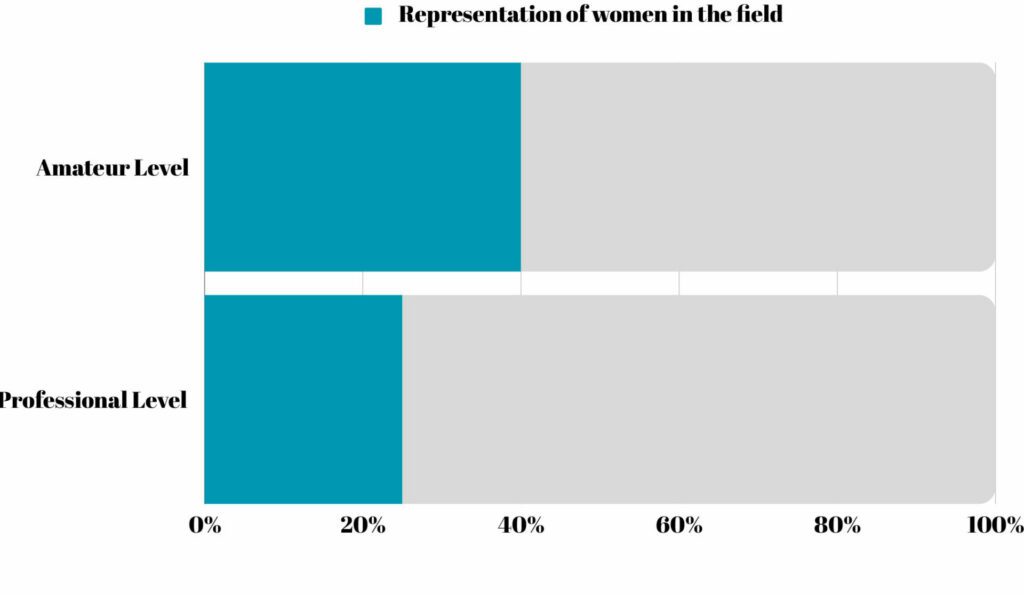
Amateur Level
- Participation: Around 40% of respondents at the amateur level are women, showcasing a rising trend in participation.
- Analysis: At the amateur level, the survey data reveals a promising trend with around 40% of respondents being women. This indicates a substantial presence and a rising trend of women actively engaging in astronomy as a hobby. The data suggests that the field is becoming more inclusive, with women taking a keen interest in astronomical observations and explorations. It reflects a positive trend where astronomy is being embraced by a diverse group of enthusiasts, fostering a rich and inclusive community of amateur astronomers.
Professional Level
- Participation: Approximately 25% of respondents at the professional level are women, indicating a need for increased representation and equal opportunities.
- Analysis: Moving to the professional sphere, the representation of women stands at around 25%, according to the survey data. While this showcases that women are indeed a part of the professional astronomical community, it also highlights a gap in representation. The data indicates a need for concerted efforts to encourage more women to pursue careers in this field, ensuring equal opportunities and fostering a diverse and inclusive professional environment. It calls attention to the necessity of addressing potential barriers that might be hindering a higher representation of women at the professional level, including encouraging young girls to pursue STEM education and promoting policies that facilitate gender equality in the workplace.
The survey data offers a nuanced view of the current landscape of women’s representation in the field of astronomy. While there is a notable presence of women both at the amateur and professional levels, the data also underscores the need for continued efforts to enhance representation, particularly in the professional sphere. It paints a picture of a field that is gradually becoming more inclusive, with a growing number of women finding a place in the community of astronomy enthusiasts. However, it also serves as a reminder to work towards a more equitable landscape where women have equal opportunities to thrive and contribute to the field, bringing diverse perspectives and enriching the astronomical community.
Conclusion
The comprehensive survey conducted among a diverse group of 3207 individuals has unearthed a wealth of insights into the current landscape of the telescope and astronomy niche. Spanning various facets including telescope usage preferences, astrophotography tools, popular astronomy apps, and the representation of women in the field, the survey paints a vivid picture of a community united by a shared passion for the cosmos.
A notable trend across several categories is the significant interest and engagement at the amateur level, with many individuals nurturing their curiosity through the use of telescopes, apps, and participation in astrophotography. The data showcases a vibrant and growing community of amateur astronomers, characterized by a diverse range of interests and a willingness to invest in their passion.
The discovery of exoplanets stands out as a particularly captivating area in the field of astronomical discoveries, reflecting a society deeply intrigued by the mysteries of the universe and the potential for groundbreaking discoveries in the search for extraterrestrial life.
On the topic of solar system exploration, there is a clear indication of a community largely supportive of space initiatives, harboring a keen interest in the advancements and opportunities that space exploration can usher in for humanity. However, the commercialization of space presents a more nuanced picture, revealing a balanced divide in opinions and showcasing a field ripe for discussion and deliberation.
While the survey highlights a rising trend in the participation of women at the amateur level, it also underscores the need for increased representation and equal opportunities in the professional sphere, calling for sustained efforts to foster diversity and inclusivity in the field.
As we look at the sky quality data, it is evident that dark sky reserves are highly valued for astronomical observations, emphasizing the importance of preserving such environments for future generations of astronomers.
Insights
The survey offers a rich tapestry of insights, reflecting a community that is both diverse and dynamic, with a deep-seated curiosity and a fervent desire to explore the celestial wonders that adorn our night sky. It is a testament to the universal appeal of astronomy, a field that continues to inspire wonder and foster a deep connection with the cosmos.
As we forge ahead, it is imperative to nurture this spirit of exploration and discovery, encouraging educational initiatives and fostering a culture that values scientific inquiry and the pursuit of knowledge. The data calls upon stakeholders — from educational institutions to policymakers and industry leaders — to work collaboratively in nurturing a vibrant, inclusive, and forward-looking astronomical community, ready to unravel the mysteries of the universe, one star at a time.
